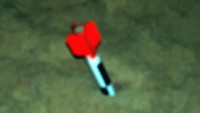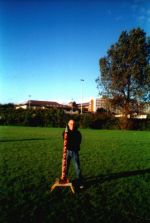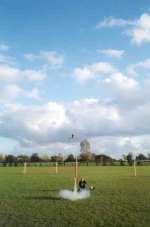
My Model Rockets
I bought my first Estes kit when I was about 15. I can't remember the name of it, but I do remember buying it 'cause it was the one which go the highest according to the packet. I also bought the most powerful motors it could take. Well, I built it, and rushed straight out to fly it, not even waiting for the glue to dry. Upon ejection, the motor mount blew out the back, and the rocket came in ballistic. It took me and a couple of friends about an hour searching the long grass to find it. After that I was hooked. I went out and bought a Mean Machine, 'cause it was six-foot tall. I built that, and also, rather than put a new motor mount in the first rocket, I decided to just shove a D12 up it. Well you can guess what happened. Up it went, parachute ejected, watched it drift away on the breeze, never to be seen again. The Mean Machine flew several flights successfully, and after surviving a CATO and being troden on and repaired several times, I finally retired it when it was driven over by a Transit van after landing on the Keynsham by-pass. Ah well.
Anyway, enough rambling. This page details my more recent model rockets.
Named after the HARP project's gun launched rockets that were built in the 1960's by Dr. Gerald Bull's research group (see here, here and here for an overview of the project and more info on Bull), this is launched from an MoD surplus rocket launcher tube that I got from a friend Andy's father, who runs a scrap metal business. Initially the rocket will be tube launched, but hopefully I will also gun-launch this rocket at a later date (for an explanation of the difference between tube-launch and gun-launch see Dave Hall's page).
In order to survive the high-stress of being gun-launched, this rocket is built much sturdier than your average model rocket. The rear section containing an Estes D12 engine is made of 1" schedule 40 PVC pipe. Around this is two wraps of epoxy and carbon-fibre tissue, not to strengthen it but to give something for the fins to adhere too (epoxy will not stick to PVC well). The fins are 5mm plywood, epoxied to the carbon-fibre and then filleted with kevlar pulp-reinforced epoxy. The upper section of the fuselage is a piece of 32mm wastepipe (I think it is polypropylene, but I may be wrong?) from Homebase, which has almost exactly the same outside diameter as the 1" PVC (in fact, after the PVC is wrapped with the carbon fibre, they are identical). The nose cone is an Estes ogive plastic nose cone, filled with plaster of paris, since alot of noseweight is needed because the back end of the rocket is so heavy.
Because of the high altitudes I am hoping this rocket will reach when it is gun-launched, the recovery system is two 4" x 5' (100mm x 150mm) streamers, minimising how far the rocket drifts on the wind. The streamers are cut from a foil space-blanket that I got when I completed the Boston Marathon. They glint in the sunlight, making it very easy to follow the rocket down and spot it on the ground. The rocket is perhaps a little heavy for streamer recovery, but it is built so sturdily, it doesn't suffer any damage on landing.
Update. 31st August 2001
The Martlet has now flown twice. First time was without gun launch, just from the tube, to check on the stability of the rocket, recovery system, etc. This went perfectly, the streamers deployed just past apogee (a five second delay on an Estes D12) and no damage (except for a little scorching of the paint at the base of the fins) was suffered.
The second flight was a full gun-launch. A 3" piece of quickmatch was Super-Glue'd into the nozzle, which was supposed to ensure ignition of the rocket engine. A piston was constructed of corrugated card to push the rocket out of the tube and not waste too much of the charge in the gun. A whole was made in the piston so that the hot gun gases would ignite the quickmatch. A 30g charge of BP was used.
The gun fired fine, shooting the rocket out perfectly, the quickmatch ignited, but unfortunately failed to ignite the rocket motor. The next time I will probably use a BP paste, painted into and around the nozzle, to ignite the engine (just like Dave Hall does). The rocket lawn-darted about 30 yards away, but no damage was suffered, again except for the paintwork. This is another reason it is built very solidly.
 |
The lawn-dart (beach-dart!). The image is out-of-focus because it was getting dark, and was hard to focus the camera. (photo: Gareth Pope) (42K) |
This idea originated at IRW2000, at Largs in Scotland. I hadn't any rockets to fly, so myself and the two other guys I went up with sat around in a field, watching other people's rockets fly, and drinking beer. We were considering buying some bits from Pete Davy and building a rocket, when it came to us: why not use our empty beer cans, and build a rocket from them? We never did, but when I got home from Largs I went for it. Just a stack of beer cans epoxied together, three beer mats for stability epoxied to the bottom, and a Threshers off-license carrier bag as a parachute (and a clear acetate nose cone taped on, so that it was pointy and looked a bit like a rocket rather than a stack of beer cans). It flew fairly well on an Estes D12, but I'd chosen a delay far too long (seven seconds!) and it came in ballistic and landed in a tree, stripping all the fins off in the process.
But it was cool! I decided to build another beer can rocket, but this time from Brains SA cans. Brains is the largest brewery here in Wales, producing some excellent beer, the most famous of which is SA (often known as Skull Attack for the hangover it can produce when consumed in excess). The Builders Arms in Oxford Street, Swansea kindly provided some Brains SA beer mats to match the cans, and I picked up a carrier bag from the Brains Brewery shop in Cardiff for a parachute.
The first flight was less than optimum - eight cans is too tall and heavy (and seven seconds is still too long a delay - I never seem to learn).
 |
Me posing with the rocket on the launch pad before lift-off. (93K) |
 |
Lift-off! |
 |
The impact site. In the larger image, you can see pieces of rocket (OK, empty beer cans) scattered around. (66K) |
However, four cans and a 3-second delay works very nicely. This rocket flew perfectly several times, so I recently converted it to a two-stage design. Unfortunately it was lost on its second flight with version one of my home-made altimeter on board. When the second stage ignited, it veered sharply and headed into the thickest patch of brambles in Wales (probably), never to be seen again. Anyway, I reckon it is because the inter-stage coupler was not rigid enough, so it is currently being redesigned and rebuilt.